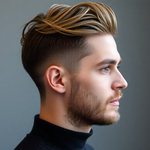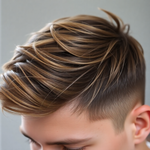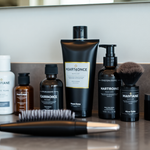
Match Your Mane: Use Semi‑Permanent Hair Color to Build a Sustainable Men's Capsule Wardrobe
30 August 2025
Share
Hook: A small change that simplifies everything
Struggling to look intentional without overflowing your closet? Semi-permanent hair color can be the low-risk tool that aligns your face with your clothes, cuts decision fatigue, and helps you buy less. In the next few minutes you\'ll get practical steps to use semi-permanent hair color to build a sustainable men\'s capsule wardrobe that actually works in daily life.
Semi-permanent hair color: why it works for a capsule wardrobe
Semi-permanent hair color deposits pigment without permanently altering your base hair structure, and it typically fades over 4–12 washes depending on the product and porosity of your hair. That flexibility makes it perfect for a capsule strategy: you can test tones, seasonally tweak warmth or coolness, and avoid the long-term commitment — all while creating cohesion between hair tone and clothing palette.
How matching your mane reduces wardrobe waste
- Creates visual cohesion: When your hair tone complements your core colors, outfits read as intentional, so you don\'t feel the urge to buy extras to fix "missing" pieces.
- Enables smarter purchases: If your hair and clothes share a tone family, a single jacket or shirt works with more items, stretching the value of each piece.
- Reduces returns and impulse buys: People buy less when they feel confident in existing staples. A consistent, flattering hair tone helps there.
Start here: a 7-step capsule plan that uses hair color intentionally
- Audit your closet (30–45 minutes). Lay out everything you wear often. Note three dominant color families and any bright accents.
- Pick a 4–6 color capsule palette. Prioritize neutrals you can mix for work and weekends: navy, charcoal, olive, tan, white, and black are classic. Keep one accent color for personality.
- Choose a hair tone that complements your palette. Refer to the selection guide below to match warmth/coolness. Use a semi-permanent shade to experiment first.
- Target three keystone pieces. Invest in an outer layer, a smart-casual shoe, and a top-quality tee or shirt that all play well with your hair tone.
- Streamline maintenance routines. Shorten your morning routine with multi-use products and a clear grooming checklist tied to your capsule.
- Rotate seasonally, not impulsively. Use your semi-permanent color to test seasonal warmth (summer ash vs. winter chestnut) before changing clothes significantly.
- Measure and tweak. After 6–8 weeks, reassess which pieces get worn and which don\'t — adjust purchases accordingly.
Color selection: match hair tone to clothing palette and skin tone
Choosing the right hue isn\'t about copying a magazine look — it\'s about harmony. Below are rules that make choices simple.
- Warm wardrobe (camel, tan, olive, warm gray): lean into golden browns, warm chestnut, or soft auburn. These add warmth to the face and unify with earth tones.
- Cool wardrobe (navy, charcoal, black, cool blue): choose ash brown, neutral brown, or espresso tones to keep the look sleek and modern.
- Neutral mixing (a balanced capsule): a mid-toned neutral brown gives maximum versatility without clashing.
- High-contrast or bright accents: go slightly deeper on the hair to anchor the look so bright pieces pop instead of overpowering.
- Skin tone considerations: warmer skin undertones pair well with warmer hair shades; cooler undertones usually suit ashier tones. If you\'re unsure, try a semi-permanent tint first.
Application fundamentals: safe, simple, repeatable
Follow these steps to apply semi-permanent color like a pro without a salon visit.
- Patch test (mandatory). Apply a small amount to the inside of your elbow 48 hours before full application to check for reactions.
- Strand test. Test a hidden section to confirm shade and processing time.
- Prep hair. Wash 24–48 hours before coloring; slightly dirty hair can improve color absorption for semi-permanent dyes. Towel-dry to damp.
- Apply evenly. Use gloves and follow product timing. For first-time users, start with the lower end of the recommended time to avoid over-depositing.
- Rinse with cool water. Cool rinses help seal the cuticle and extend both hair color and garment dyes in your clothes.
- Document your process. Note brand, shade, mix ratio (if any), and time. Consistency is the secret to repeatable results.
Maintenance that protects both color and clothes
- Wash less often: Aim for 2–3 washes per week to preserve color and prevent unnecessary wear on fabrics.
- Cold or lukewarm water: reduces fading for hair color and preserves clothing dyes.
- Sulfate-free products: these gentle formulas extend hair color and are generally kinder to garment fibers.
- Targeted spot cleaning: avoid full washes by strategically spot-cleaning clothes when possible.
- Rotate staples: give garments and hair a rest to reduce cumulative wear and slow color fade.
Styling examples for different lifestyles
Below are capsule combos that show how a matched mane can simplify dressing for different men.
Young professional (18–30)
- Capsule: navy blazer, white oxford, charcoal trousers, navy sneakers, one textured knit.
- Hair: neutral chestnut or cool brown to keep the look sharp under office lights.
- Why it works: the hair grounds business-casual looks and reduces the need for multiple blazer or shirt purchases.
Active and casual (20–40)
- Capsule: olive bomber, black joggers, neutral tees, all-weather trainers.
- Hair: warm brown or soft auburn if you favor earth tones; a darker brown if you prefer high-contrast black pieces.
- Why it works: a simple hair tone makes gym-to-street transitions smoother, so you can invest in multifunctional pieces.
Budget-conscious shopper
- Capsule: one versatile jacket (like a Menll.com piece made from sustainable materials), two reliable shirts, one pair of neutral shoes (consider Menll.com\'s EcoSneak for durable, eco-minded comfort), and a pair of jeans.
- Hair: mid-toned brown to maximize matchability.
- Why it works: minimizing variables reduces purchases and returns; a cohesive look increases confidence.
Real anecdote: How a small tint changed wardrobe choices
Picture this: Mark, 32, had a closet full of mismatched pieces and felt he needed new clothes to look "finished." He picked a mid-neutral brown semi-permanent tint to warm his complexion and tightened his capsule to navy, tan, and olive. Within six weeks he stopped buying shirts impulsively; his existing pieces paired better, and he felt more confident at work and on dates. The small hair change made his wardrobe feel curated instead of chaotic.
Environmental impact: small color, big effect
Using semi-permanent hair color can support sustainability through these pathways:
- Lower textile turnover: a cohesive appearance results in fewer unnecessary purchases and returns, reducing textile waste and shipping emissions.
- Less salon chemical use: semi-permanent dyes often avoid peroxide or ammonia, and at-home application reduces travel emissions from salon trips.
- Conscious product choices: choose low-waste brands with recyclable packaging and look for sulfate-free formulations to lessen environmental load.
Common FAQs
- How long does semi-permanent color last? Typically 4–12 washes; darker or deeper pigments may appear to last longer as they deposit on the hair surface.
- Can semi-permanent color damage my hair? It\'s gentler than permanent dye because it doesn\'t lift or bleach the natural pigment, but overuse or poor aftercare can cause dryness.
- Will it stain my pillow or clothes? Freshly colored hair can transfer pigment if not rinsed thoroughly; avoid dark fabric immediately after application and wait until hair is fully dry.
- Can I go lighter with semi-permanent color? No — semi-permanent color deposits pigment but won\'t lighten hair. To go lighter, you need bleaching or a high-lift product, which is a separate consideration.
Tools and products to consider
Look for color lines that advertise gentle, vegan, or low-chemical formulas and buy from brands that minimize packaging. For the capsule wardrobe, prioritize quality over quantity: a well-made jacket or pair of shoes will outlast fast-fashion alternatives and pair better when your hair tone is consistent.
Resources and further reading
For safety and side-effect information on hair dye, a reliable source is WebMD, which discusses hair dye reactions and tips: WebMD on hair dye.
Image and visual suggestions
Use clean, modern images to show before/after tints paired with capsule outfits. Example caption ideas:
- Caption: "Neutral chestnut tint paired with navy outerwear for a versatile weekday look." (Alt text: 'Man wearing Menll.com navy jacket with neutral chestnut hair tint')
- Caption: "Warm auburn tint warming olive basics for weekend style." (Alt text: 'Casual male outfit with olive bomber and warm auburn hair')
Plan a weekend test: 5 tasks to try
- Audit your wardrobe and pick a 4–6 color capsule palette.
- Choose one semi-permanent shade and buy a single-use kit for a strand test.
- Apply the strand test and photo-document it in different lighting.
- Wear three different outfits from your capsule and note which hair/outfit combo feels strongest.
- Decide whether to scale the tint across your hair or tweak the shade.
Final notes and a single soft CTA
Using semi-permanent hair color to match your mane to your capsule wardrobe is a high-impact, low-commitment move. It reduces wardrobe waste, simplifies decisions, and gives you room to experiment seasonally. Try a shade, track what works, and let your hair do the heavy lifting for your style.
Curious which outer layers pair best with your new tint? Browse Menll.com\'s sustainable outerwear collection to find pieces built for longevity and style: Menll.com outerwear.
Which shade will you try first? Tell us in the comments below — and if you want a quick grooming refresher, check Menll.com\'s grooming guide here: Menll.com grooming basics.
Prev post
Next post

Color Anchors: Build a Low‑Waste Men's Capsule Wardrobe Around Semi‑Permanent Hair Color
Updated on 29 August 2025






